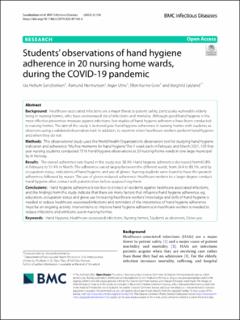| dc.contributor.author | Sandbekken, Ida Hellum | |
| dc.contributor.author | Hermansen, Åsmund | |
| dc.contributor.author | Utne, Inger | |
| dc.contributor.author | Grov, Ellen Karine | |
| dc.contributor.author | Løyland, Borghild | |
| dc.date.accessioned | 2022-04-06T11:37:48Z | |
| dc.date.available | 2022-04-06T11:37:48Z | |
| dc.date.created | 2022-02-14T20:35:44Z | |
| dc.date.issued | 2022-02-14 | |
| dc.identifier.issn | 1471-2334 | |
| dc.identifier.uri | https://hdl.handle.net/11250/2990203 | |
| dc.description.abstract | Background: Healthcare-associated infections are a major threat to patient safety, particularly vulnerable elderly living in nursing homes, who have an increased risk of infections and mortality. Although good hand hygiene is the most effective preventive measure against infections, few studies of hand hygiene adherence have been conducted in nursing homes. The aim of this study is to investigate hand hygiene adherence in nursing homes with students as observers using a validated observation tool. In addition, to examine when healthcare workers perform hand hygiene and when they do not.
Methods: This observational study used the World Health Organization’s observation tool for studying hand hygiene indication and adherence: “My fve moments for hand hygiene.” For 1 week each in February and March 2021, 105 first-year nursing students conducted 7316 hand hygiene observations at 20 nursing home wards in one large municipality in Norway.
Results: The overall adherence rate found in this study was 58.3%. Hand hygiene adherence decreased from 65.8% in February to 51.4% in March. The adherence varied largely between the different wards, from 26.4 to 83.1%, and by occupation status, indications of hand hygiene, and use of gloves. Nursing students were found to have the greatest adherence, followed by nurses. The use of gloves reduced adherence. Healthcare workers to a larger degree conduct hand hygiene after contact with patients than before approaching them.
Conclusions: Hand hygiene adherence is too low to protect all residents against healthcare-associated infections, and the fndings from this study indicate that there are many factors that infuence hand hygiene adherence, eg., education, occupation status and glove use Increasing healthcare workers’ knowledge and skills of hand hygiene is needed to reduce healthcare-associated infections and reminders of the importance of hand hygiene adherence must be an ongoing activity. Interventions to improve hand hygiene adherence in healthcare workers is needed to reduce infections and antibiotic use in nursing homes. | en_US |
| dc.description.sponsorship | This study is part of a Ph.D.-project that is funded by the Norwegian Nurses Organization (Ref. 4207). | en_US |
| dc.language.iso | eng | en_US |
| dc.publisher | BMC | en_US |
| dc.relation.ispartofseries | BMC Infectious Diseases;22, Article number: 156 (2022) | |
| dc.rights | Navngivelse 4.0 Internasjonal | * |
| dc.rights.uri | http://creativecommons.org/licenses/by/4.0/deed.no | * |
| dc.subject | Hand hygiene | en_US |
| dc.subject | Healthcare-associated infections | en_US |
| dc.subject | Nursing homes | en_US |
| dc.subject | Students as observers | en_US |
| dc.subject | Glove use | en_US |
| dc.title | Students’ observations of hand hygiene adherence in 20 nursing home wards, during the COVID-19 pandemic | en_US |
| dc.type | Peer reviewed | en_US |
| dc.type | Journal article | en_US |
| dc.description.version | publishedVersion | en_US |
| dc.rights.holder | © The Author(s) 2022 | en_US |
| dc.source.articlenumber | 156 | en_US |
| cristin.ispublished | true | |
| cristin.fulltext | original | |
| cristin.qualitycode | 1 | |
| dc.identifier.doi | https://doi.org/10.1186/s12879-022-07143-6 | |
| dc.identifier.cristin | 2001566 | |
| dc.source.journal | BMC Infectious Diseases | en_US |
| dc.source.volume | 22 | en_US |
| dc.source.issue | 22 | en_US |
| dc.source.pagenumber | 1-9 | en_US |
| dc.relation.project | Norsk Sykepleierforbund: 4207 | en_US |

